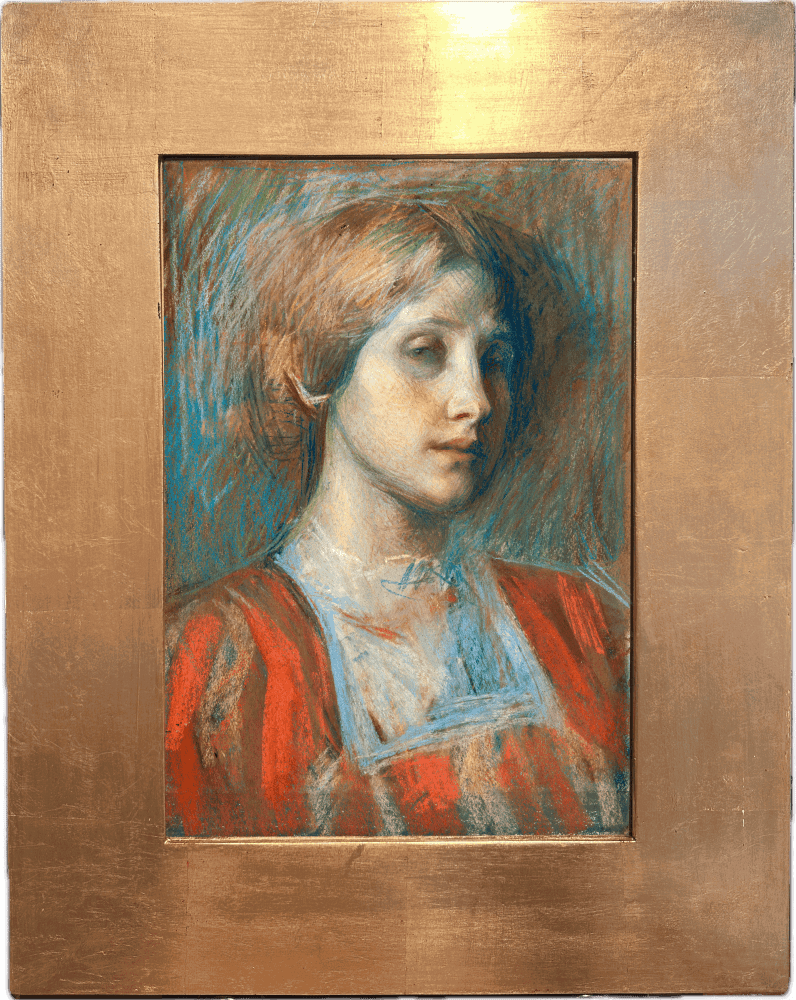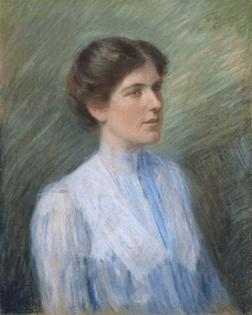-
Artworks


Umberto BOCCIONI (Reggio Calabria 1882-Verona 1916)
Portrait of a Young Girl, 1905 c.Pastel on cardboard50,7 x 35 cm
70 x 55 x 2 cm (with the frame)SOLD
Provenance
Private collection
Exhibitions
Boccioni prefuturista, Reggio Calabria, Museo Nazionale, July - September 1983 and Rome, Palazzo Venezia, October - November 1983; Umberto Boccioni (1882-1916). Genio e memoria, Milan, Palazzo Reale, March – July 2016; Boccioni prima del futurismo. Opere 1902-1910, Mamiano di Traversetolo, Parma, Fondazione Magnani Rocca, September - December 2023.
Literature
M. Calvesi, E. Coen, Boccioni. L’opera completa, 1983, p. 226, cat. 279 (dated 1908-1909); Boccioni prefuturista, Milan 1983, p. 115, cat. 143 (dated 1908-1909); Umberto Boccioni (1882-1916). Genio e memoria, 2016, pp. 100, 298, cat. 84 (titled Ritratto di giovane donna, dated 1907-1908); M. Calvesi, A. Dambruoso, Umberto Boccioni. Catalogo generale, 2016, p. 264, cat. 165 (datato 1903); Boccioni prima del futurismo. Opere 1902-1910, 2023, p. 123, cat. 87 (dated 1905 c.).
Considering the enormous contribution that his art had on the Italian and European scene, it is hard to believe that Umberto Boccioni lived for only 34 years. A major figure of the 20th century, a leading player of the European avant-garde, his rebellious spirit was coupled with ceaseless experimentation while he remained constantly open to “the new”.
When we speak of Umberto Boccioni, we immediately think of Futurism (and specifically the variety known as Early Futurism, whose demise coincided with Boccioni’s death) and the ideas of speed, dynamism and strength expressed in the works of the artists who adhered to it. That said, not nearly enough attention is paid to the figure of the young Boccioni and his formative years, years of brilliance, fruitful experimentation and intense artistic ferment. His short but incredibly incisive artistic career, which lasted just nine years, can be divided into three fundamental phases which corresponded geographically to three Italian cities: Rome – Venice – Milan, interspersed with brief international experiences which, combined with his innate curiosity, were to play a key role in defining his artistic language.Rome was the city where the young Boccioni developed every significant premise for his Futurist evolutions. Some works from this period, “in which components that are fundamental in Boccioni’s future research are intertwined – the poetics of the state of mind and post-impressionist naturalism with its saturations and fusions of light and atmosphere”[1] – show that the Roman avant-garde circles played a decisive role in the artist’s formation, highlighting also that Boccioni possessed great in-depth knowledge of colour and its use. Fascinated by Divisionism, he tried his hand at the challenging technique of pastel that allowed him to fix rapid and immediate colour impressions, and through his cross-hatching, Boccioni became able to fully exploit all of the medium’s potential.This incredible pastel on cardboard, Portrait of a Young Girl, which has recently been dated to around 1905, therefore belongs to his “Roman period”, even if it was already hinting at later dynamic developments. The artist had earlier abandoned his delicate palette of pastel shades of the works from a couple of years earlier (Fig. 1), to now come to use brighter timbres, with more incisive, broken strokes.
Fig. 1 - Ritratto femminile, 1903
Guido and Ettore De Fornaris Foundation, on loan to the GAM
In Portrait of a Young Girl, the background appears to be cut in a circular motion by unflinching marks of blue pastel. These incisive features spread out from the young girl’s head and illuminate her face, while the figure acquires volume thanks to the play on colours. In short, it is as if Boccioni were constructing the very plasticity of the figure through the colour.
Referring to those years in Rome, Boccioni said that he looked “to Munich and Vienna, as centres of plastic thought (...) Klimt was considered by us to be an aristocratic innovator of style.”[2] These words of Boccioni underline how much the culture of the Viennese Secession, but also and above all, those of Munich and Berlin, played a fundamental role.In this intense portrait, in its expressive force, the swirling movement of colour, the incisive marks and the thread-like tracery of primary colours, it is possible to trace, with very little effort, the influence of Munch. As E. Coen put it, “... Boccioni’s personality was formed in Rome, from an intersection between Balla’s lessons (which meant an elaboration of French Impressionism and Italian Divisionism) and the pro-Secessionist interests of the Roman circle.”[3]Portrait of a Young Girl exactly encapsulates the seedling of the artist’s genius and embodies the “intersection” of these essential lessons for Umberto Boccioni’s artistic life.The work was shown recently at the exhibition Boccioni 1900-1910, at the Magnani Rocca Foundation in Mamiano di Traversetolo, Parma.
Join the mailing list
Subscribe to our newsletter to receive all the news about exhibitions, fairs and new acquisitions!
